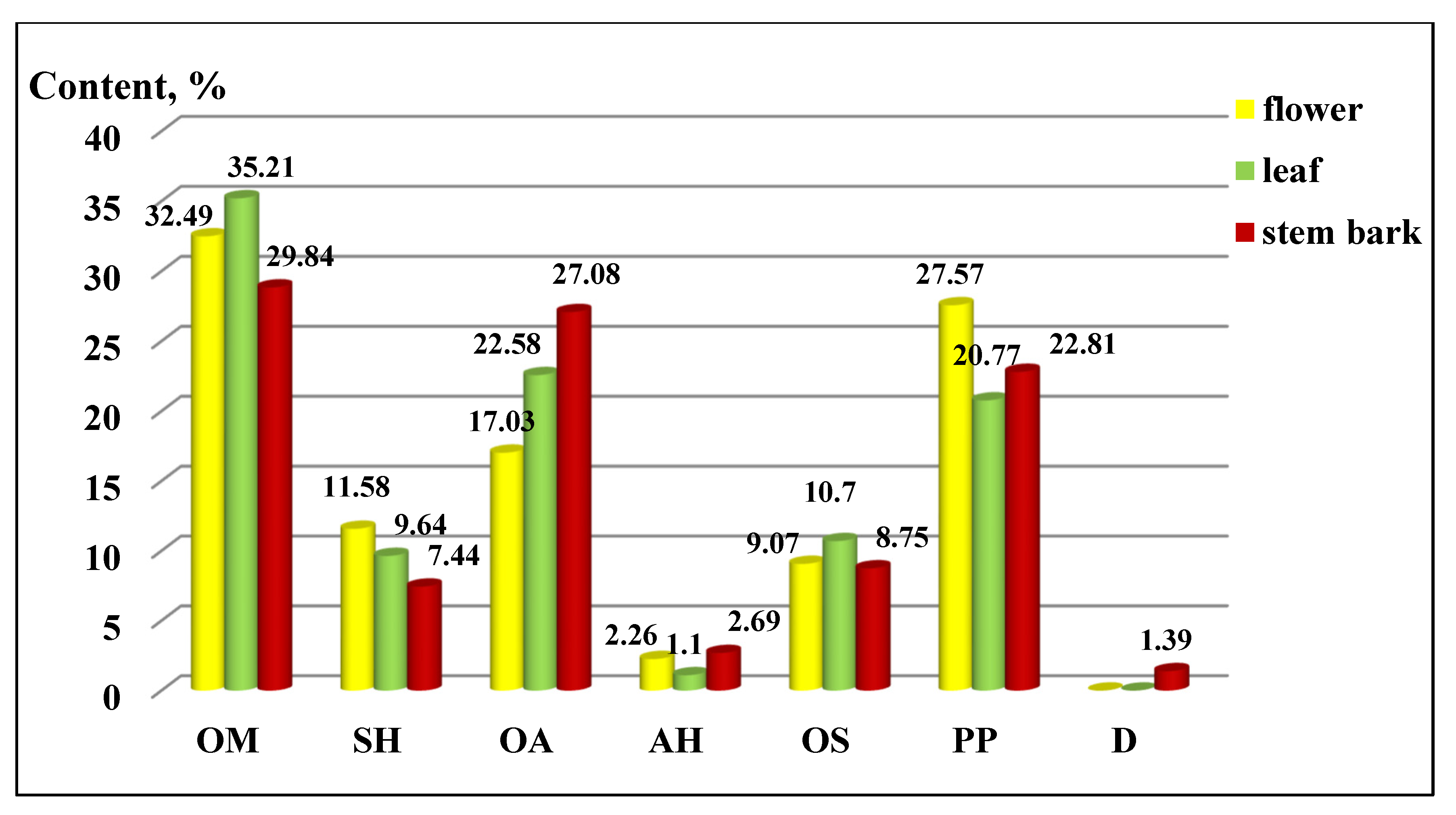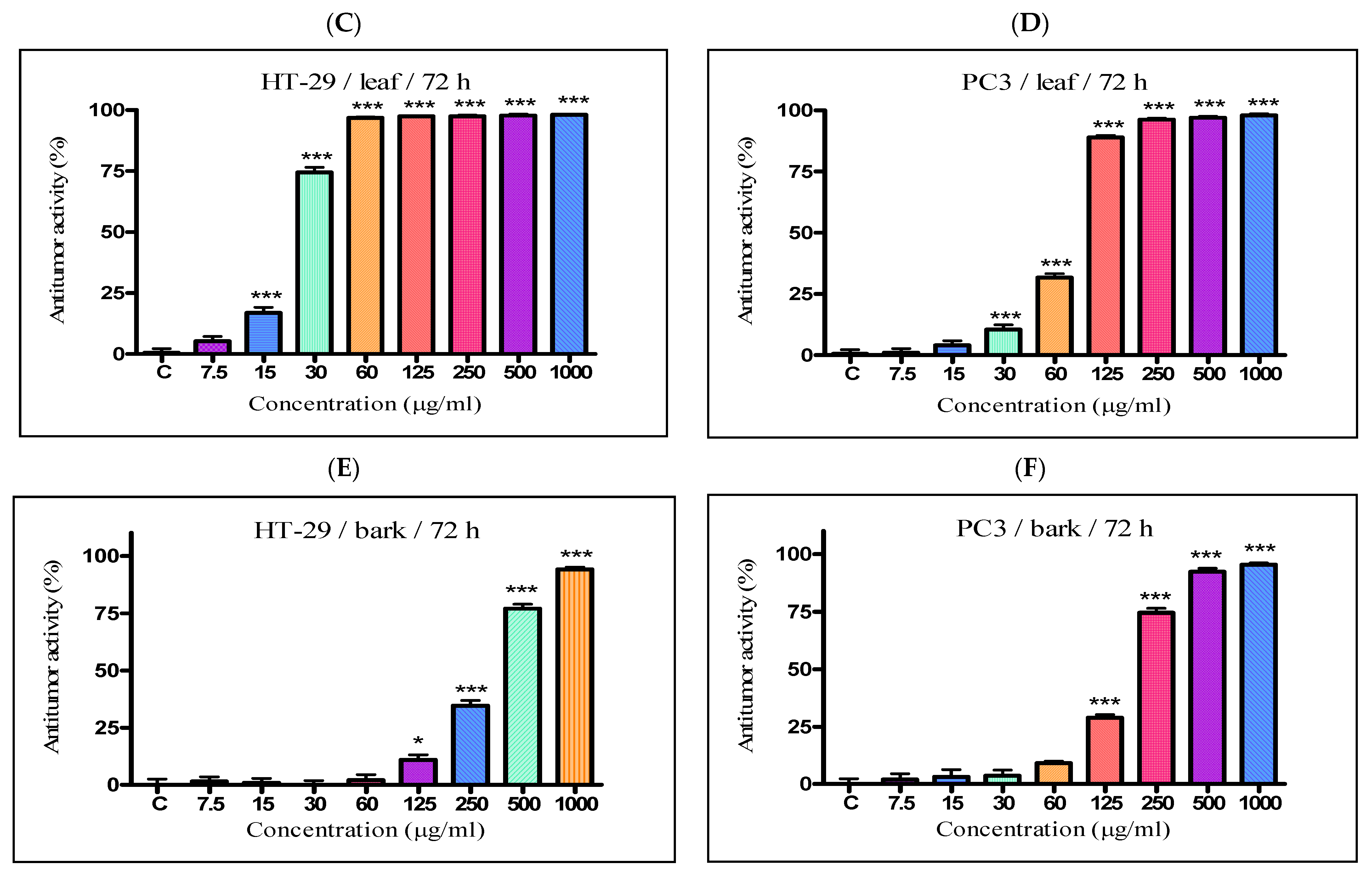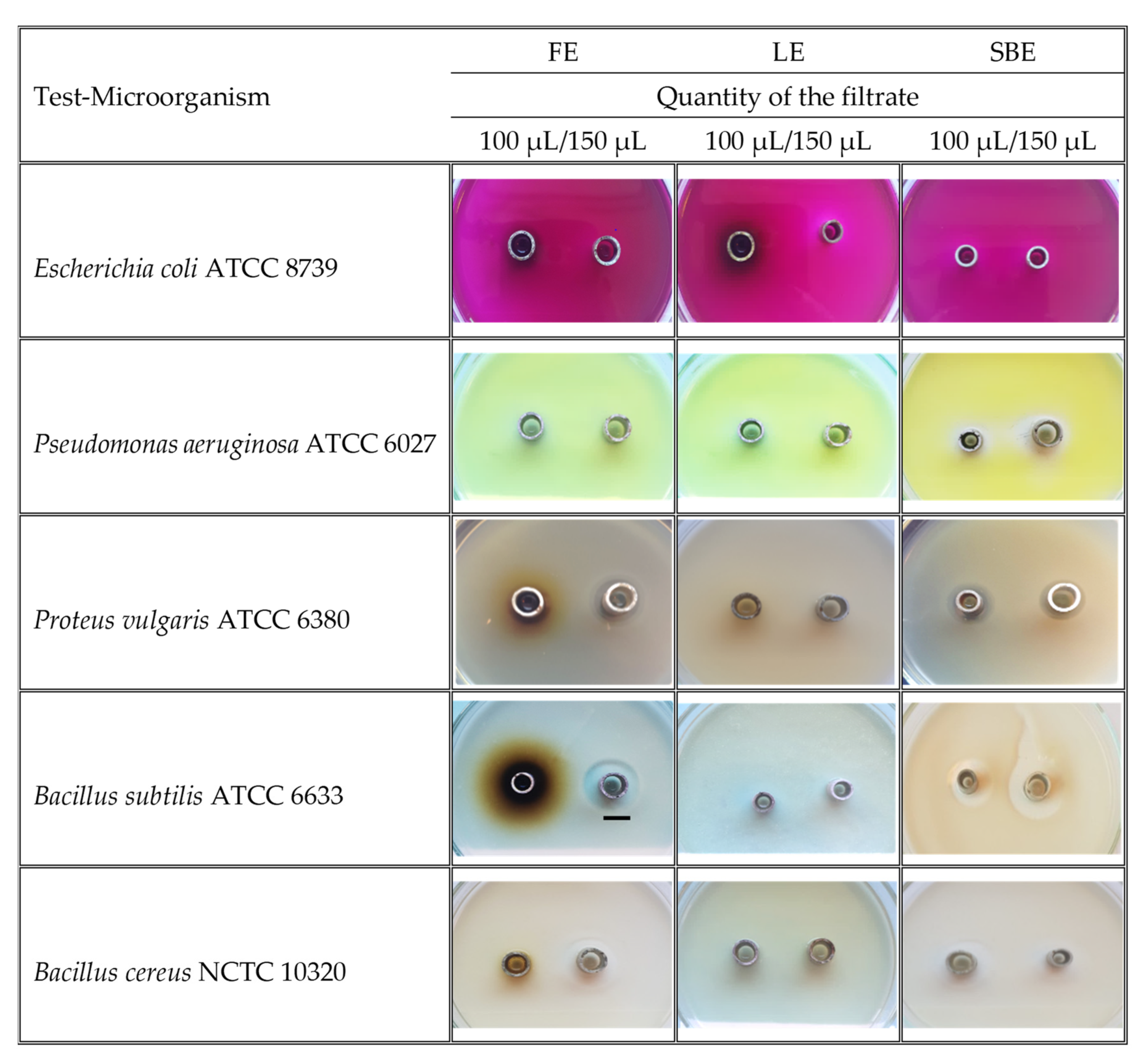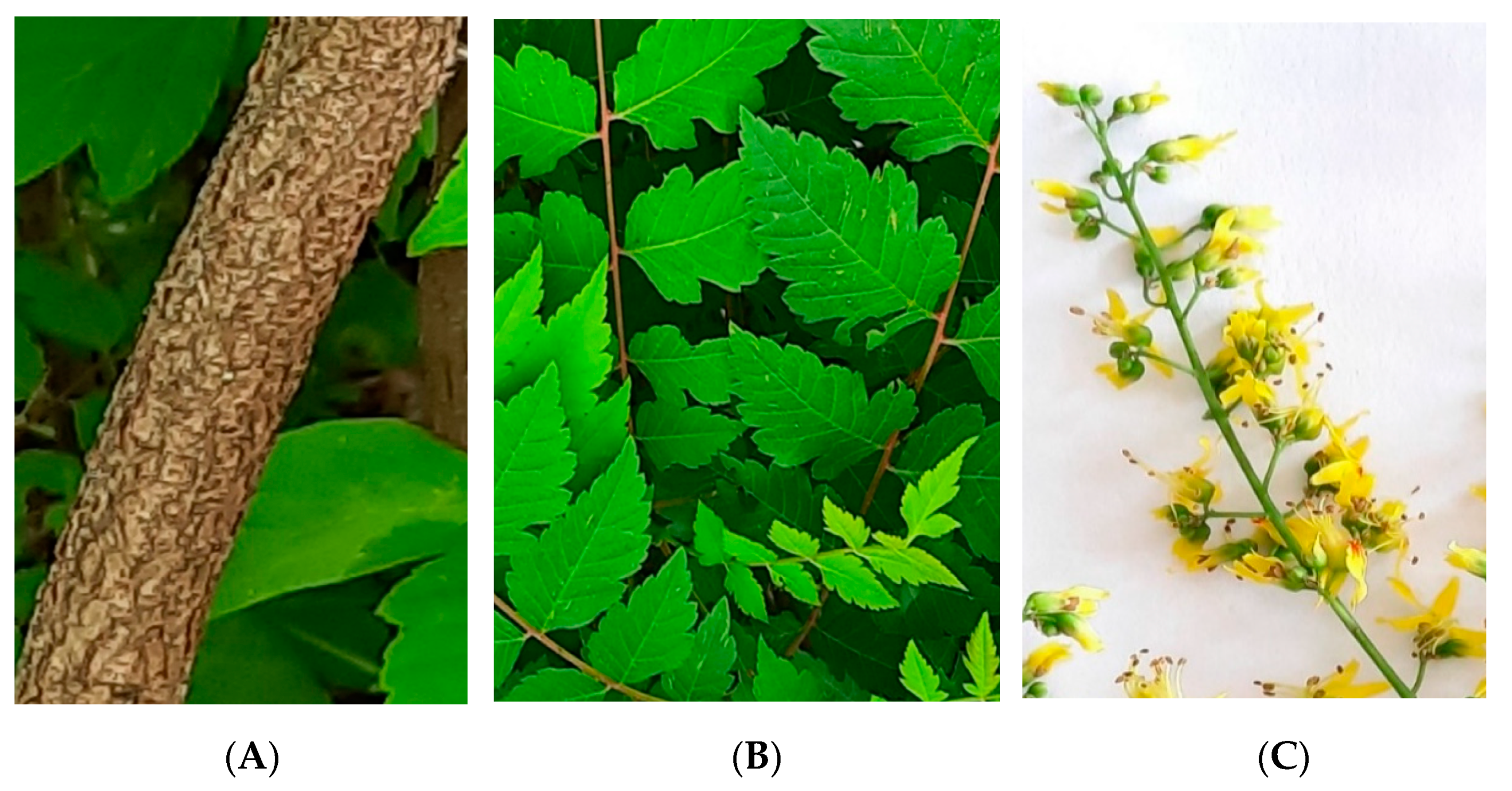Chemical Compounds, Antitumor and Antimicrobial Activities of Dry Ethanol Extracts from Koelreuteria paniculata Laxm
Abstract
1. Introduction
2. Results and Discussion
2.1. Chemical Compounds of Dry Ethanol Extracts from Aerial Parts of K. paniculata
2.2. Antitumor Activity of the K. paniculata Ethanol Dry Extracts
2.3. Antimicrobial Activity of the K. paniculata Ethanol Dry Extracts
3. Materials and Methods
3.1. Plant Material Collection and Identification
3.2. Preparation of Dry Plant Extracts
3.3. Cell Lines, Test-Microorganisms and Nutrient Media
3.4. Gas Chromatography-Mass Spectrometry (GC-MS) and GC-FID Analyses
3.5. Antitumor Activity Assay
3.6. Antimicrobial Activity Assay
3.7. Statistical Analysis
4. Conclusions
Author Contributions
Funding
Institutional Review Board Statement
Informed Consent Statement
Data Availability Statement
Conflicts of Interest
References
- Ghahari, S.; Alinezhad, H.; Nematzadeh, G.A.; Ghahari, S. Phytochemical screening and antimicrobial activities of the constituents isolated from Koelreuteria paniculata leaves. Nat. Prod. Res. 2015, 29, 1865–1869. [Google Scholar] [CrossRef]
- Mostafa, A.E.; El-Hela, A.A.; Mohammad, A.E.I.; Cutler, S.J.; Ross, S.A. Antimalarial compounds isolated from Koelreuteria paniculata growing in Egypt. Planta Med. 2015, 81, PC7. [Google Scholar] [CrossRef]
- Chouhan, S.; Sharma, K.; Guleria, S. Antimicrobial activity of some essential oils—Present status and future perspectives. Medicines 2017, 4, 58. [Google Scholar] [CrossRef] [PubMed]
- Manandhar, S.; Luitel, S.; Dahal, R.K. In vitro antimicrobial activity of some medicinal plants against human pathogenic bacteria. J. Trop. Med. 2019, 2019, 1–5. [Google Scholar] [CrossRef] [PubMed]
- Zazharskyi, V.V.; Davydenko, P.O.; Kulishenko, O.M.; Borovik, I.V.; Zazharska, N.M.; Brygadyrenko, V.V. Antibacterial and fungicidal activities of ethanol extracts of 38 species of plants. Biosyst. Divers. 2020, 28, 281–289. [Google Scholar] [CrossRef]
- Borah, P.; Banik, B.K. Medicinal plants and their compounds with anticancer properties. In Green Approaches in Medicinal Chemistry for Sustainable Drug Design; Elsevier: Amsterdam, The Netherlands, 2020; pp. 759–776. ISBN 978-0-12-817592-7. [Google Scholar]
- Hadadi, Z.; Nematzadeh, G.A.; Ghahari, S. A study on the antioxidant and antimicrobial activities in the chloroformic and methanolic extracts of 6 important medicinal plants collected from North of Iran. BMC Chem. 2020, 14, 1–11. [Google Scholar] [CrossRef] [PubMed]
- Álvarez-Martínez, F.J.; Barrajón-Catalán, E.; Herranz-López, M.; Micol, V. Antibacterial plant compounds, extracts and essential oils: An updated review on their effects and putative mechanisms of action. Phytomedicine 2021, 90, 153626. [Google Scholar] [CrossRef] [PubMed]
- Petrova, A.; Vladimírov-Hurban, V.; Georgiev, V. Invasive Alien Species of Vascular Plants in Bulgaria; Institue of Biodiversity and Ecosystem Research, Bulgarian Academy of Sciences: Sofia, Bulgaria, 2013; ISBN 954-9746-30-5. [Google Scholar]
- Ljubojević, M.; Tomić, M.; Simikić, M.; Savin, L.; Narandžić, T.; Pušić, M.; Grubač, M.; Vejnović, S.; Marinković, M. Koelreuteria paniculata invasiveness, yielding capacity and harvest date influence on biodiesel feedstock properties. J. Environ. Manag. 2021, 295, 113102. [Google Scholar] [CrossRef] [PubMed]
- Lin, W.-H.; Deng, Z.-W.; Lei, H.-M.; Fu, H.-Z.; Li, J. Polyphenolic compounds from the leaves of Koelreuteria paniculata Laxm. J. Asian Nat. Prod. Res. 2002, 4, 287–295. [Google Scholar] [CrossRef] [PubMed]
- Mostafa, A.E.; El-Hela, A.A.; Mohammad, A.-E.I.; Cutler, S.J.; Ross, S.A. New triterpenoidal saponins from Koelreuteria paniculata. Phytochem. Lett. 2016, 17, 213–218. [Google Scholar] [CrossRef] [PubMed]
- Yang, Y.; Zheng, D.; Zhao, Y.; Wang, T.; Yang, Y.; Peng, W. Analysis of components in Koelreuteria paniculata. Caribb. J. Sci. 2017, 50, 13–18. [Google Scholar]
- Wang, Y.; Zheng, D.; Zhao, Y.; Wang, T.; Yang, Y.; Ashraf, M.A.; Peng, W. Active components in branches and leaves of Koelreuteria paniculata. Caribb. J. Sci. 2018, 51, 11–21. [Google Scholar]
- Wang, Y.; Liu, Q.; Zheng, D.; Zhao, Y.; Wang, T.; Yan, S.; Gu, H. Active constituents of Koelreuteria paniculata root. Therm. Sci. 2020, 24, 1737–1744. [Google Scholar] [CrossRef]
- Qu, Q.-H.; Zhang, L.; Bao, H.; Zhang, J.-H.; You, X.-J.; Wang, J.-X. Chemical constituents of flavonoids from flowers of Koelreuteria paniculata. Zhong Yao Cai Zhongyaocai J. Chin. Med. Mater. 2011, 34, 1716–1719. [Google Scholar]
- Andonova, T.; Dimitrova-Dyulgerova, I.; Slavov, I.; Muhovski, Y.; Stoyanova, A. A Comparative Study of Koelreuteria Paniculata Laxm. Aerial Parts Essential Oil Composition. J. Essent. Oil Bear. Plants 2020, 23, 1363–1370. [Google Scholar] [CrossRef]
- Kumar, M.; Chandel, M.; Kumar, S.; Kaur, S. Studies on the antioxidant/genoprotective activity of extracts of Koelreuteria paniculata Laxm. Am. J. Biomed. Sci 2012, 1, 177–189. [Google Scholar]
- Zhelev, I.; Georgiev, K.; Dimitrova-Dyulgerova, I. In-vitro antioxidant and antineoplastic activities of carotenoids from flowers of Koelreuteria paniculata. World J. Pharm. Res. 2016, 5, 53–60. [Google Scholar] [CrossRef]
- Tinh, T.H.; Nuidate, T.; Vuddhakul, V.; Rodkhum, C. Antibacterial Activity of Pyrogallol, a Polyphenol Compound against Vibrio Parahaemolyticus Isolated from the Central Region of Thailand. Procedia Chem. 2016, 18, 162–168. [Google Scholar] [CrossRef]
- Gabbrielli, G.; Loggini, F.; Cioni, P.L.; Giannaccini, B.; Mancuso, E. Activity of lavandino essential oil against non-tubercular opportunistic rapid grown mycobacteria. Pharmacol. Res. Commun. 1988, 20, 37–40. [Google Scholar] [CrossRef]
- Baricault, L.; Denariaz, G.; Houri, J.-J.; Bouley, C.; Sapin, C.; Trugnan, G. Use of HT-29, a Cultured Human Colon Cancer Cell Line, to Study the Effect of Fermented Milks on Colon Cancer Cell Growth and Differentiation. Carcinogenesis 1995, 16, 245–252. [Google Scholar] [CrossRef] [PubMed]
- Cooperberg, M.R.; Park, S.; Carroll, P.R. Prostate Cancer 2004: Insights from National Disease Registries. Oncol. Williston Park NY 2004, 18, 1239–1247. [Google Scholar]
- Ahn, H.; Im, E.; Lee, D.Y.; Lee, H.-J.; Jung, J.H.; Kim, S.-H. Antitumor Effect of Pyrogallol via MiR-134 Mediated S Phase Arrest and Inhibition of PI3K/AKT/Skp2/CMyc Signaling in Hepatocellular Carcinoma. Int. J. Mol. Sci. 2019, 20, 3985. [Google Scholar] [CrossRef] [PubMed]
- Kowalik, K.; Paduch, R.; Strawa, J.W.; Wiater, A.; Wlizło, K.; Waśko, A.; Wertel, I.; Pawłowska, A.; Tomczykowa, M.; Tomczyk, M. Potentilla Alba Extracts Affect the Viability and Proliferation of Non-Cancerous and Cancerous Colon Human Epithelial Cells. Molecules 2020, 25, 3080. [Google Scholar] [CrossRef]
- Rajiv, C.; Roy, S.S.; Tamreihao, K.; Kshetri, P.; Singh, T.S.; Devi, H.S.; Sharma, S.K.; Ansari, M.A.; Devi, E.D.; Devi, A.K.; et al. Anticarcinogenic and Antioxidant Action of an Edible Aquatic Flora Jussiaea Repens L. Using In Vitro Bioassays and In Vivo Zebrafish Model. Molecules 2021, 26, 2291. [Google Scholar] [CrossRef] [PubMed]
- Kumar, M.; Kumar, S.; Kaur, S. Investigations on DNA protective and antioxidant potential of chloroform and ethyl acetate fractions of Koelreuteria paniculata Laxm. Afr. J. Pharm. Pharmacol. 2011, 5, 421–427. [Google Scholar] [CrossRef][Green Version]
- Kumar, M.; Kaur, S. Golden rain tree leaf extracts as potential inhibitor of lipid peroxidation and 4-nitroquinoline-1-oxide (4-NQO)-induced DNA damage. Afr. J. Biotechnol. 2011, 10, 19758–19763. [Google Scholar] [CrossRef]
- Abo-Elghiet, F.; Ibrahim, M.; Sleem, A.A. Anticancer activity of isolated compounds from twigs of Koelreuteria elegans cultivated in Egypt. Azhar Int. J. Pharm. Med. Sci. 2021, 1, 23–29. [Google Scholar] [CrossRef]
- Baser, K.H.C.; Buchbauer, G. Hand Book of Essential Oils: Science, Technology, and Applications; Taylor and Francis Group, LLC CRC Pressisanimprintof Taylor &Francis Group, an Informa Business: Boca Raton, FL, USA, 2010. [Google Scholar] [CrossRef]
- Ham, Y.; Yang, J.; Choi, W.-S.; Ahn, B.-J.; Park, M.-J. Antibacterial Activity of Essential Oils from Pinaceae Leaves Against Fish Pathogens. J. Korean Wood Sci. Technol. 2020, 48, 527–547. [Google Scholar] [CrossRef]
- Vaičiulytė, V.; Ložienė, K.; Švedienė, J.; Raudonienė, V.; Paškevičius, A. α-Terpinyl Acetate: Occurrence in Essential Oils Bearing Thymus Pulegioides, Phytotoxicity, and Antimicrobial Effects. Molecules 2021, 26, 1065. [Google Scholar] [CrossRef]
- Tajkarimi, M.M.; Ibrahim, S.A.; Cliver, D.O. Antimicrobial herb and spice compounds in food. Food Control 2010, 21, 1199–1218. [Google Scholar] [CrossRef]
- Hummel, J.; Strehmel, N.; Selbig, J.; Walther, D.; Kopka, J. Decision tree supported substructure prediction of metabolites from GC-MS profiles. Metabolomics 2010, 6, 322–333. [Google Scholar] [CrossRef] [PubMed]
- Mosmann, T. Rapid colorimetric assay for cellular growth and survival: Application to proliferation and cytotoxicity assays. J. Immunol. Methods 1983, 65, 55–63. [Google Scholar] [CrossRef]
- Balouiri, M.; Sadiki, M.; Ibnsouda, S.K. Methods for in vitro evaluating antimicrobial activity: A review. J. Pharm. Anal. 2016, 6, 71–79. [Google Scholar] [CrossRef] [PubMed]







| Peak | RT | RIcalc | RIlit | Compound | K. paniculata, % of TIC | Compounds Identification | ||
|---|---|---|---|---|---|---|---|---|
| Flower | Leaf | Stem Bark | ||||||
| 1 | 4.49 | 1174 | 1170 | Furfuryl butanoate | nd | nd | nd | |
| 2 | 4.68 | 1190 | 1186 | (3Z)-Hexenyl butanoate | 0.81 ± 0.0 | 0.49 ± 0.0 | 0.97 ± 0.01 | GMD |
| 3 | 4.79 | 1197 | 1199 | γ-terpineol | 3.78 ± 0.10 | 0.85 ± 0.01 | 0.55 ± 0.0 | GMD |
| 4 | 5.10 | 1206 | 1202 | (2E,4E)-Hexadienol isobutanoate | 0.13 ± 0.0 | 2.00 ± 0.07 | 2.66 ± 0.08 | GMD |
| 5 | 5.20 | 1218 | 1217 | (2E,4E)-Nonadienol | 0.20 ± 0.0 | 3.53 ± 0.09 | 4.68 ± 0.11 | GMD |
| 6 | 5.26 | 1225 | 1223 | Methyl nonanoate | 0.58 ± 0.0 | 0.22 ± 0.0 | 0.44 ± 0.0 | GMD |
| 7 | 5.30 | 1233 | 1228 | Nerol | nd | 0.49 ± 0.0 | 1.71 ± 0.05 | GMD |
| 8 | 5.41 | 1231 | 1229 | (3Z)-Hexenyl 2-methyl butanoate | 0.36 ± 0.0 | 3.78 ± 0.10 | 8.15 ± 0.20 | GMD |
| 9 | 5.60 | 1288 | 1288 | Lavandulol acetate | 0.47 ± 0.01 | 3.40 ± 0.09 | 2.02 ± 0.06 | GMD |
| 10 | 6.11 | 1316 | 1315 | δ-terpinyl acetate | 0.12 ± 0.0 | 0.71 ± 0.0 | 0.93 ± 0.01 | GMD |
| 11 | 6.23 | 1345 | 1346 | α-terpinyl acetate | 16.42 ± 0.51 | 20.24 ± 0.07 | 3.56 ± 0.09 | GMD |
| 12 | 6.35 | 1359 | 1360 | Neryl acetate | 0.15 ± 0.0 | 0.33 ± 0.0 | 12.37 ± 0.40 | GMD |
| 13 | 6.40 | 1362 | 1361 | Pyrogallol | 20.86 ± 0.70 | 2.02 ± 0.07 | 1.91 ± 0.05 | NIST’08 |
| 14 | 6.55 | 1366 | 1363 | α-methyl benzyl butyrate | nd | 0.30 ± 0.0 | 0.82 ± 0.0 | GMD |
| 15 | 6.64 | 1375 | 1378 | (3Z)-Hexenyl hexanoate | nd | 0.79 ± 0.0 | 0.78 ± 0.0 | GMD |
| 16 | 6.82 | 1386 | 1386 | Isobutyl phenylacetate | nd | 1.13 ± 0.04 | 1.69 ± 0.04 | GMD |
| 17 | 6.94 | 1394 | 1395 | Ethyl decanoate | 5.85 ± 0.12 | 1.40 ± 0.05 | 1.47 ± 0.04 | GMD |
| 18 | 7.01 | 1401 | 1400 | n-tetradecane | 2.13 ± 0.07 | 1.08 ± 0.04 | 2.65 ± 0.07 | GMD |
| 19 | 7.08 | 1416 | 1417 | β-caryophyllene | 2.61 ± 0.07 | 3.86 ± 0.08 | 2.91 ± 0.07 | GMD |
| 20 | 7.12 | 1432 | 1433 | α-trans-bergamotene | 2.45 ± 0.07 | 0.95 ± 0.01 | 0.93 ± 0.01 | GMD |
| 21 | 7.16 | 1439 | 1438 | Phenyl ethyl butanoate | 3.89 ± 0.08 | 2.94 ± 0.08 | 2.89 ± 0.08 | GMD |
| 22 | 7.26 | 1453 | 1453 | Geranyl acetone | nd | 1.80± | 2.53 ± 0.07 | GMD |
| 23 | 7.41 | 1465 | 1466 | Linalool isovalerate | nd | 0.92 ± 0.01 | 1.42 ± 0.03 | GMD |
| 24 | 7.47 | 1469 | 1468 | n-dodecanol | 2.21 ± 0.07 | 0.99 ± 0.01 | 1.90 ± 0.04 | GMD |
| 25 | 7.51 | 1472 | 1471 | α-terpinyl isobutanoate | 10.32 ± 0.40 | 4.77 ± 0.10 | 3.56 ± 0.09 | GMD |
| 26 | 7.55 | 1476 | 1479 | α-curcumene | nd | 0.45 ± 0.0 | nd | GMD |
| 27 | 7.64 | 1481 | 1482 | γ-curcumene | nd | 0.58 ± 0.0 | nd | GMD |
| 28 | 7.72 | 1486 | 1485 | Phenyl ethyl 2-methylbutanoate | 0.75 ± 0.0 | 3.21 ± 0.08 | 3.84 ± 0.09 | GMD |
| 29 | 7.76 | 1488 | 1489 | β-selinene | 3.01 ± 0.07 | 2.60 ± 0.07 | 2.63 ± 0.07 | GMD |
| 30 | 7.97 | 1497 | 1498 | α-selinene | 3.36 ± 0.08 | 0.66 ± 0.0 | 0.72 ± 0.0 | GMD |
| 31 | 8.15 | 1511 | 1514 | β-curcumene | nd | 0.33 ± 0.0 | 0.15 ± 0.0 | GMD |
| 32 | 8.26 | 1556 | 1552 | Lauric acid | 1.93 ± 0.03 | 0.88 ± 0.0 | 0.36 ± 0.0 | NIST’08 |
| 33 | 8.41 | 1562 | 1560 | Geranyl butanoate | 0.81 ± 0.0 | 0.55 ± 0.0 | 0.78 ± 0.0 | GMD |
| 34 | 8.50 | 1568 | 1570 | Octyl hexanoate | 0.40 ± 0.0 | 0.62 ± 0.0 | 0.51 ± 0.0 | NIST’08 |
| 35 | 8.56 | 1576 | 1573 | Decyl butyrate | 0.64 ± 0.0 | 0.37 ± 0.0 | 0.44 ± 0.0 | NIST’08 |
| 36 | 8.71 | 1611 | 1611 | Tetradecanal | 0.20 ± 0.0 | 0.74 ± 0.0 | 0.82 ± 0.0 | GMD |
| 37 | 8.83 | 1623 | 1622 | Isobutyl cinnamate | nd | 1.22 ± 0.02 | 1.50 ± 0.02 | GMD |
| 38 | 9.07 | 1640 | 1639 | Phenyl ethyl hexanoate | 1.71 ± 0.03 | 9.05 ± 0.10 | 8.67 ± 0.07 | GMD |
| 39 | 9.17 | 1649 | 1650 | β-eudesmol | 0.42 ± 0.0 | 0.90 ± 0.01 | 0.69 ± 0.0 | GMD |
| 40 | 9.26 | 1654 | 1652 | α-eudesmol | 0.27 ± 0.0 | 0.72 ± 0.0 | 1.12 ± 0.02 | GMD |
| 41 | 9.37 | 1662 | 1661 | Dihydro-eudesmol | 0.35 ± 0.0 | 1.35 ± 0.02 | 1.93 ± 0.03 | GMD |
| 42 | 9.61 | 1671 | 1670 | Epi-β-bisabolol | 2.19 ± 0.07 | 3.03 ± 0.07 | 1.51 ± 0.02 | GMD |
| 43 | 9.67 | 1675 | 1674 | β-bisabolol | 2.88 ± 0.07 | 1.44 ± 0.02 | 1.66 ± 0.02 | GMD |
| 44 | 9.86 | 1690 | 1691 | (Z)-α-trans-Bergamotol | 2.00 ± 0.06 | 2.52 ± 0.07 | 1.00 ± 0.02 | GMD |
| 45 | 10.21 | 1699 | 1698 | (2Z,6Z)-Farnesol | 0.84 ± 0.0 | 0.51 ± 0.0 | 0.72 ± 0.0 | GMD |
| 46 | 10.50 | 1706 | 1704 | δ-dodecalactone | 0.97 ± 0.01 | 0.30 ± 0.0 | 0.57 ± 0.0 | GMD |
| 47 | 10.82 | 1718 | 1718 | Methyl eudesmate | nd | 0.45 ± 0.0 | 1.18 ± 0.02 | GMD |
| 48 | 11.93 | 1826 | 1825 | (E)-Nerolidyl isobutyrate | nd | 0.39 ± 0.0 | nd | GMD |
| 49 | 14.49 | 1953 | 1948 | Phytol | nd | nd | 0.14 ± 0.0 | GMD |
| 50 | 14.61 | 1971 | 1966 | Palmitic acid | 1.85 ± 0.05 | 0.86 ± 0.0 | 1.16 ± 0.02 | GMD |
| 51 | 14.73 | 1992 | 1990 | Ethyl palmitate | 0.29 ± 0.0 | nd | nd | GMD |
| 52 | 16.67 | 2018 | 2019 | (6E,10Z)-Pseudo phytol | nd | nd | 0.42 ± 0.0 | GMD |
| 53 | 16.85 | 2026 | 2024 | Isopropyl hexadecanoate | nd | 0.79 ± 0.0 | 0.25 ± 0.0 | GMD |
| 54 | 16.94 | 2029 | 2030 | (6E,10E)-Pseudo phytol | nd | nd | 0.81 ± 0.0 | GMD |
| 55 | 18.05 | 2133 | 2132 | Linoleic acid | 0.16 ± 0.0 | 4.32 ± 0.04 | 1.55 ± 0.02 | GMD |
| 56 | 18.28 | 2142 | 2141 | Oleic acid | 0.23 ± 0.0 | nd | nd | GMD |
| 57 | 21.58 | 2400 | 2400 | Tetracosane | 0.10 ± 0.0 | nd | nd | GMD |
| Total identified, % | 98.70 | 97.83 | 98.63 | |||||
| IC50 of Mean ± SD (µg/mL) | ||
|---|---|---|
| HT-29 | PC3 | |
| Flower extract | 21.44 ± 0.20 | 58.76 ± 0.53 |
| Leaf extract | 23.63 ± 0.22 | 80.56 ± 0.75 |
| Stem Bark extract | 339.4 ± 1.31 | 182.8 ± 1.65 |
| Cisplatin | 2.5 ± 0.08 | 1.01 ± 0.03 |
| Test-Microorganism | QF | FE | LE | SBE | CH |
|---|---|---|---|---|---|
| Gram-negative bacteria | |||||
| Escherichia coli ATCC 8739 | 150 μL | - * | 9.02 a ± 0.01 | - | 28.05 b ± 0.01 |
| 100 μL | - | 6.02 a ± 0.01 | - | ||
| Salmonella enterica NCTC 6017 | 150 μL | - | - | - | 24.04 ± 0.03 |
| 100 μL | - | - | - | ||
| Klebsiella (clinical isolate) | 150 μL | - | - | - | 21.03 ± 0.03 |
| 100 μL | - | - | - | ||
| Pseudomonas aeruginosa ATCC 6027 | 150 μL | - | - | 14.02 c ± 0.01 | 21.03 c ± 0.03 |
| 100 μL | - | - | 5.03 c ± 0.01 | ||
| Proteus vulgaris ATCC 6380 | 150 μL | 10.04 d ± 0.02 | - | 8.04 d ± 0.01 | - |
| 100 μL | 6.05 d ± 0.04 | - | 6.02 d ± 0.01 | ||
| Gram-positive bacteria | |||||
| Staphylococcus aureus ATCC 25093 | 150 μL | - | - | - | 25.03 ± 0.03 |
| 100 μL | - | - | - | ||
| Bacillus subtilis ATCC 6633 | 150 μL | 14.03 e ± 0.03 | - | 18.04 e ± 0.02 | 39.04 f ± 0.03 |
| 100 μL | 11.03 e ± 0.04 | - | 11.03 e ± 0.02 | ||
| Bacillus cereus NCTC 10320 | 150 μL | 14.0 6 g ± 0.03 | - | 14.03 g ± 0.02 | - |
| 100 μL | - | - | 6.02 g ± 0.01 | ||
| Listeria monocytogenes NCTC 11994 | 150 μL | - | - | - | 21.06 ± 0.02 |
| 100 μL | - | - | - | ||
Publisher’s Note: MDPI stays neutral with regard to jurisdictional claims in published maps and institutional affiliations. |
© 2021 by the authors. Licensee MDPI, Basel, Switzerland. This article is an open access article distributed under the terms and conditions of the Creative Commons Attribution (CC BY) license (https://creativecommons.org/licenses/by/4.0/).
Share and Cite
Andonova, T.; Muhovski, Y.; Fidan, H.; Slavov, I.; Stoyanova, A.; Dimitrova-Dyulgerova, I. Chemical Compounds, Antitumor and Antimicrobial Activities of Dry Ethanol Extracts from Koelreuteria paniculata Laxm. Plants 2021, 10, 2715. https://doi.org/10.3390/plants10122715
Andonova T, Muhovski Y, Fidan H, Slavov I, Stoyanova A, Dimitrova-Dyulgerova I. Chemical Compounds, Antitumor and Antimicrobial Activities of Dry Ethanol Extracts from Koelreuteria paniculata Laxm. Plants. 2021; 10(12):2715. https://doi.org/10.3390/plants10122715
Chicago/Turabian StyleAndonova, Tsvetelina, Yordan Muhovski, Hafize Fidan, Iliya Slavov, Albena Stoyanova, and Ivanka Dimitrova-Dyulgerova. 2021. "Chemical Compounds, Antitumor and Antimicrobial Activities of Dry Ethanol Extracts from Koelreuteria paniculata Laxm" Plants 10, no. 12: 2715. https://doi.org/10.3390/plants10122715
APA StyleAndonova, T., Muhovski, Y., Fidan, H., Slavov, I., Stoyanova, A., & Dimitrova-Dyulgerova, I. (2021). Chemical Compounds, Antitumor and Antimicrobial Activities of Dry Ethanol Extracts from Koelreuteria paniculata Laxm. Plants, 10(12), 2715. https://doi.org/10.3390/plants10122715






